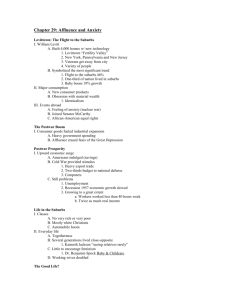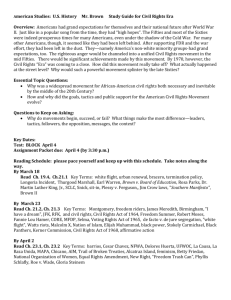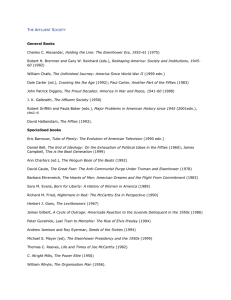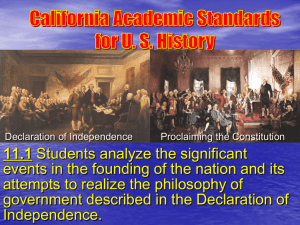Contrasting Cultures: The “Fifties” and the “Sixties”
advertisement
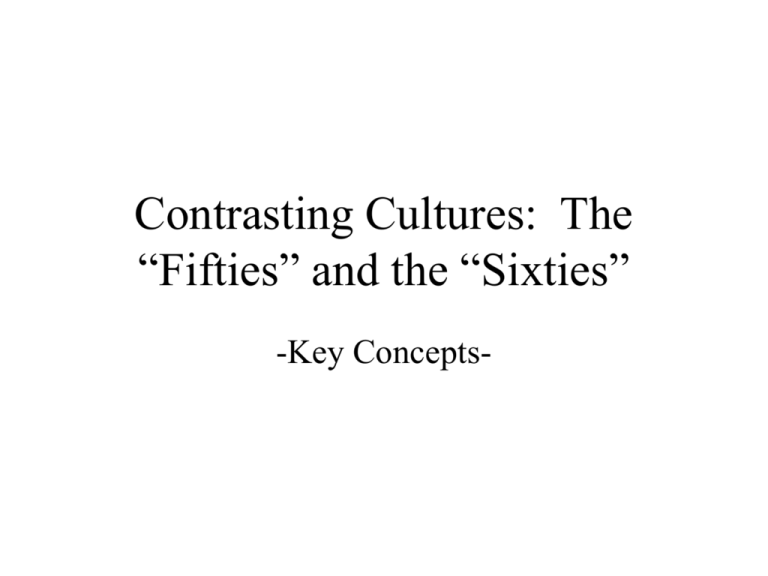
Contrasting Cultures: The “Fifties” and the “Sixties” -Key Concepts- I. The “Fifties”: Affluence and Anxiety A. Life in the Suburbs • Optimism and pessimism both characterized the 50’s • Explosion of homebuilding during the decade • Levittown • Ease of financing for new homes • Levittown “uniformity” A. Life in the Suburbs (cont.) • Diversity under the surface at Levittown • Post-war growth of American suburbs • Dramatic population growth in the “Sunbelt” • Increased mobility in the American population in general • American “car culture” A. Life in the Suburbs (cont.) • Post-War “Baby Boom” • A new “Consumer Revolution” • Origins of Fifties economic growth • Real economic growth crossed class lines A. Life in the Suburbs (cont.) • Age of the credit card arrived • Leisure hours increased • Growth of the “middle class” white-collar sector • Big business kept getting bigger A. Life in the Suburbs (cont.) • Changes in American shopping patterns • Concerns with growing materialism • The crucial role of advertising • Doubts about the strength of national character B. Life in the Home • Home became the focus of activities • “Togetherness” • Television image of family togetherness • No encouragement of feminism after WWII • Life’s “ideal” middleclass woman (1956) B. Life in the Home (cont.) • The advice of baby doctor Benjamin Spock --The Common Sense Book of Baby and Child Care (1946) • Number of working women doubled between 1940-1960 --40% of all women and 33% of all married women worked outside of the home by 1960 C. Religion and the Media • Organized religion flourished in the 50’s -- “Church shopping” • The Power of Positive Thinking (1952) • Fifties preaching avoided condemnation and controversy • Symbols of 50’s Religious Enthusiasm -- “In God We Trust” C. Religion and the Media (cont.) • Religion and the Cold War • Religion on television • “Neo-orthodoxy” and critics of 50’s religious culture • Educational controversy during the decade C. Religion and the Media (cont.) • Television became the largest growth area for an expanding American media --1946: 7,000 sets --1960: 50 million sets • TV’s impact on culture • Advertising on TV • Fifties television programming D. The Politics of the 1950’s (1) The Election of 1952 • Competition for the Republican nomination • Democrats nominated Governor Adlai Stevenson of Illinois • The Campaign and Results -- “I Like Ike” • Republicans failed to control Congress in the 50’s (2) “Dynamic Conservatism”: The Eisenhower Presidency • Eisenhower’s background and personality • Eisenhower’s controversial cabinet • Eisenhower’s priority of budget cutting • Extending the reach of the “New Deal” (2) “Dynamic Conservatism” (cont.) • Eisenhower’s heart attack and the election of 1956 • Second Term “problems” • Second Term “accomplishments” --Hawaii and Alaska statehood (1959) • Eisenhower’s “Farewell Address” -- “military-industrial” complex E. An Underlying Anxiety (1) Critics of Consumer Society • Abundance of selfcriticism in the 1950’s • David Riesman’s The Lonely Crowd (1950) -- “inner-directed” vs. “outer-directed” • Arthur Miller’s Death of a Salesman (1949) • Other literary critiques of the 1950’s (1) Critics of Consumer Society (cont.) • Critique of American business in the 50’s • The art of Edward Hopper • Art becomes increasingly abstract • The subculture of the “Beatniks” • Beatniks pursue personal versus social solutions to their anxieties (1) Critics of Consumer Society (cont.) • Beat poet Allen Ginsberg -- “Howl” (1956) • William Burroughs -- Naked Lunch (1959) • Jack Kerouac -- On the Road (1957) • Contrast with the Hippies • Anti-authority movies • The Elvis “Revolution” (2) The Second “Red Scare” • House Un-American Activities Committee (HUAC) • Presidential loyalty oaths (1947) • The Alger Hiss affair (1948) • The climate for “McCarthyism” --Ethel and Julius Rosenberg (2) The Second “Red Scare” (cont.) • “Communists in the State Department” (February of 1950) • McCarthy’s tactics • Growing fear of McCarthy in Washington, D.C. • McCarthy’s attack on “subversive” books • McCarthy and Eisenhower (2) The Second “Red Scare” (cont.) • The Army-McCarthy Hearings (1954) --Army counsel Joseph Welch • McCarthy’s demise • Spirit of McCarthyism lived on • “Frozen dissent” during the 1950’s (3) Reaction to Sputnik • Soviets launch “Sputnik” (October, 1957) • American reaction to Sputnik • NASA created (1958) • “Project Apollo” and the race to the moon • National Defense Education Act (1958) • Commission on National Goals II. The “Sixties”: Protest and Reaction A. The Politics of the 1960’s (1) The Election of 1960 • Richard Nixon (R-Ca) vs. John F. Kennedy (DMass) • The Kennedy family and political ambition -- Profiles in Courage (1956) • Campaign issues and strategies • Election Results (2) The “New Frontier” Under Kennedy • Kennedy youthfulness and Cabinet appointments --Robert McNamara • The “Kennedy” Style • Difficulties in launching a domestic program --The Peace Corps (1961) • Kennedy’s assassination (November 22, 1963) --The “Camelot” mystique B. Important Supreme Court Decisions of the 1960’s • Warren Court decisions continue to be controversial • Prohibition of school prayer (1962) • Gideon v. Wainwright (1963) • Escobedo v. Illinois (1964) • Miranda v. Arizona (1966) C. Life on College Campuses • Boom in college enrollments • A new “adversarial” culture attacking materialism • “Students for a Democratic Society” (SDS) -- “participatory democracy” --Founder: Tom Hayden -- “The New Left” C. Life on College Campuses (cont.) • Growth of the SDS • Increasing radicalism and violence • The “Weathermen” • By 1971, the “New Left” was dead • SDS as a symbol of youth in the 60’s • Still, SDS was a minority symbol of the era D. Student Revolt • Roots of student protest • The Free Speech Movement (1964) --Berkeley student leader Mario Savio • Causes of campus unrest -- “Don’t trust anyone over thirty!” • First student teach-ins at the University of Michigan (1965) D. Student Revolt (cont.) • Growing threat of the draft to college men • Draft resistance and evasion • Mass student protests at Central Park and the Pentagon (1967) • Sit-ins at Columbia University (April, 1968) • Major gains of the protest were educational E. The Cultural Revolution • Much more pervasive and influential than the political revolution of the 60’s • Values challenged through physical appearance • The rise and fall of communal living --Haight-Ashbury E. The Cultural Revolution (cont.) • The Woodstock Music Festival (August, 1969) • Protest music of the mid-60’s --Joan Baez, Bob Dylan, Simon and Garfunkel E. The Cultural Revolution (cont.) • Drug music and political radicalism of the late sixties -- “Lucy in the Sky with Diamonds” -- “You Say You Want a Revolution” --Grateful Dead and the Jefferson Airplane E. The Cultural Revolution (cont.) • The role of drugs in the Counter-Culture --Dr. Timothy Leary • The “Yippies” • The Crippling of the Cultural Revolution (1969-1970) • The commercialization of the Counter-Culture • Environmentalism becomes the new student cause of the 70’s F. Native American Nationalism • The poor, different nationalities and homosexuals all emulated the Black Power movement • The plight of Native Americans in the 60’s • Protest of sports mascots • AIM and its takeover of Alcatraz (1969) • Legal action taken G. Hispanic Nationalism • Cesar Chavez and the National Farm Workers Association --boycott strategy • Explosive growth of Hispanic American population -- “Chicanos” • Campaign for educational opportunities and programs • No more “Frito Bandito” H. Women’s Liberation • New wave of feminism grew out of other reform efforts • Signs of gender inequality during the 60’s • Betty Friedan’s The Feminine Mystique (1963) • 1964 Civil Rights Act: no job discrimination on the basis of sex H. Women’s Liberation (cont.) • Forms of protest by 60’s women activists • National Organization of Women (NOW—1966) • Division within the women’s movement • The Equal Rights Amendment (1972) • Roe v. Wade (1973) • The “quiet revolution” III. Comparisons of the Fifties and the Sixties?
